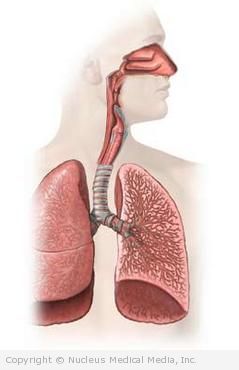Legionnaire’s disease
(Legionnaire’s Pneumonia)
Legionnaire’s disease – Definition
Legionnaire’s disease is a lung infection. It is a form of pneumonia. It got its name after it struck at the American Legionnaires Convention in 1976.
Legionnaire’s disease – Causes
This disease is caused by the bacterium Legionella pneumophilia. The bacteria are most often found in sources of standing water. It may be found in cooling towers, HVAC systems, and air conditioners. It can also be found in soil.
Legionnaire’s disease can be contracted by:
- Breathing water vapor from a standing water source that contains Legionella bacteria into the lungs
- Breathing dust from soil containing Legionella bacteria into the lungs
The infection does not move from one person to another.
Legionnaire’s disease – Risk Factors TOP
Factors that increase your chance for Legionnaire’s disease include:
- Advanced age
- Sex: male
- Smoking
- Excessive alcohol intake
- Chronic lung disease
- Weakened immune system (as with AIDS)
- People with kidney failure
- Diabetes
- Taking cortisone or other immunosuppressive drugs
- Organ transplant patients
- Working with soil, especially newly tilled soil or potting soil
Legionnaire’s disease – Symptoms TOP
Symptoms may include:
- Fatigue
- Fever (often high)
- Chills and muscle aches
- Dry cough
- Chest pain with coughing or breathing
- Loss of appetite
- Headache
Symptoms that develop if the infection becomes serious include:
- Shortness of breath
- Abdominal pain
- Nausea, vomiting, or diarrhea
- Mental problems, confusion, or memory loss
Legionnaire’s disease – Diagnosis TOP
The doctor will ask about your symptoms and medical history. A physical exam will be done.
Tests may include:
- Blood tests — to look for high or rising antibodies to Legionella bacteria
- Sputum tests — mucus from deep inside your lungs is examined to identify the cause of the infection
- Kidney function tests — poor kidney function is often seen with Legionella infection
- Urine tests — to check for Legionella proteins in the urine
- Chest x-ray — to diagnose pneumonia or lung infection
Legionnaire’s disease – Treatment TOP
This disease is usually treated with antibiotics such as:
- Quinolones
- Macrolides (eg, azithromycin, clarithromycin, or erythromycin)
- Tetracycline
In severe cases, a drug called rifampin may be given. Initial therapy may be given by vein.
If you are diagnosed with Legionnaire’s disease, follow your doctor’s instructions.
Legionnaire’s disease – Prevention TOP
Proper design, maintenance, and cleaning of high risk areas can reduce the risk of spreading the disease. This inlcludes any area with standing water.
You can reduce your risk of getting Legionnaire’s disease by:
- Not smoking
- Limiting the amount of alcohol you drink
- If you work with freshly tilled soil or potting soil:
- Wear gloves and a mask.
- Do not inhale dust from the soil.
- Moisten the soil to lower the amount of dust.

